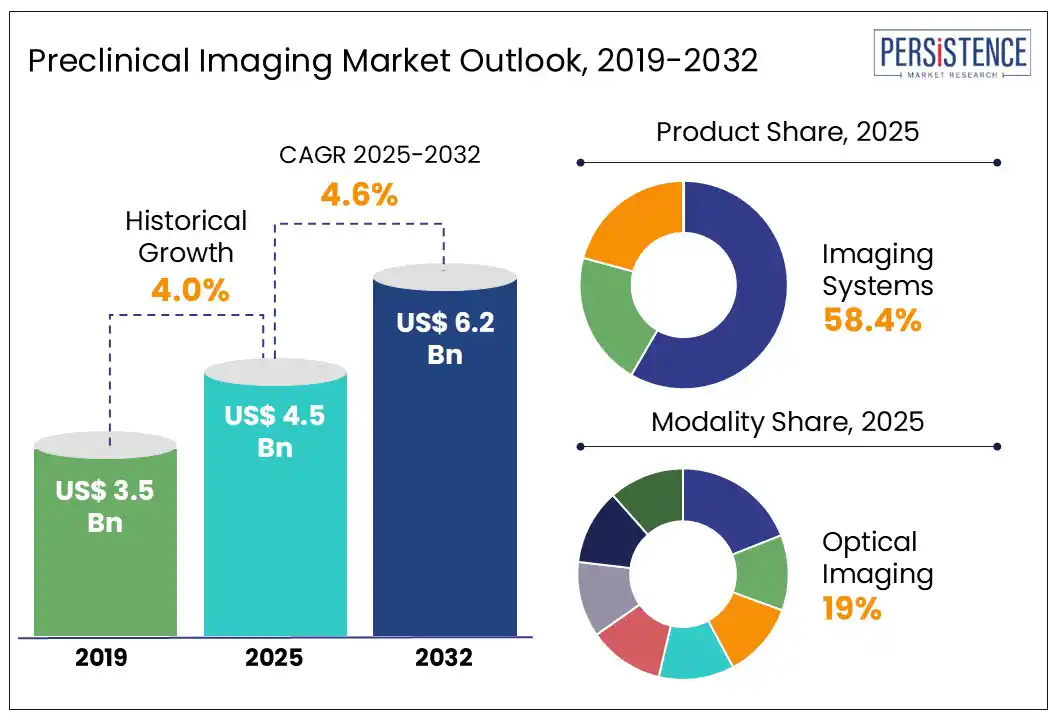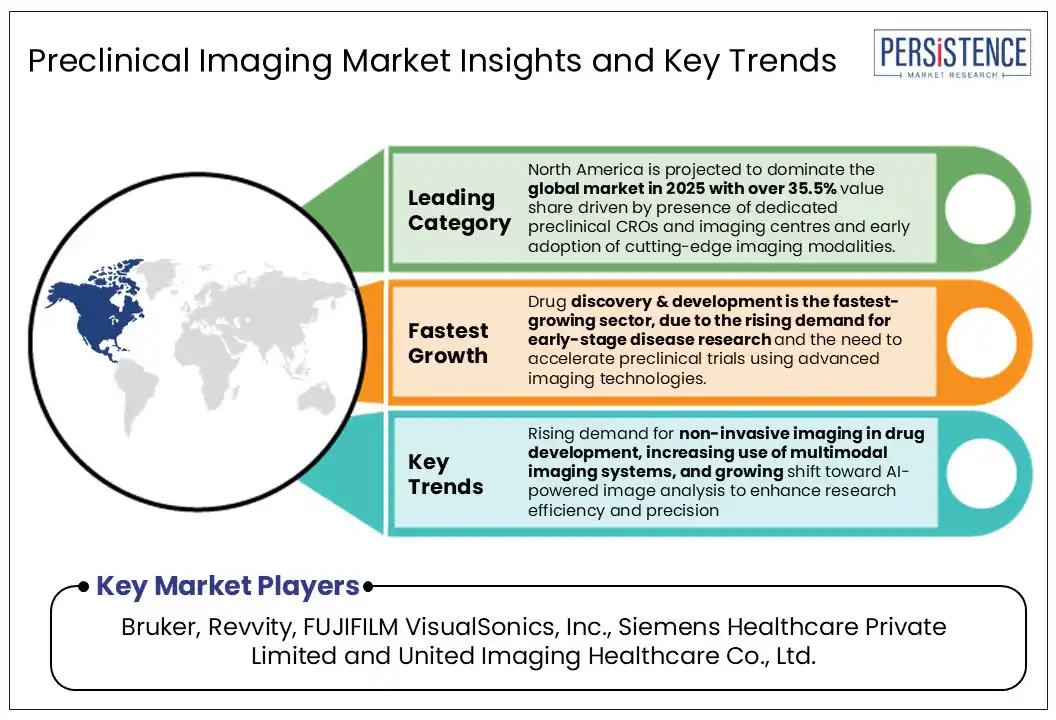ID: PMRREP34717| 198 Pages | 8 Jul 2025 | Format: PDF, Excel, PPT* | Healthcare

The global preclinical imaging market size is likely to be valued at US$4.5 Bn in 2025, and is expected to reach US$ 6.2 Bn by 2032, growing at a CAGR of 4.6% during the forecast period from 2025 to 2032.
The preclinical imaging market is poised for strong growth, driven by rising investments in pharmaceutical and biotechnology research and the increasing prevalence of chronic diseases. The growing adoption of multimodal imaging systems that combine anatomical and functional data enables more comprehensive analysis. Additionally, expanding contract research organizations (CROs) and advancements in AI-powered image analysis are enhancing research efficiency, fuelling further market expansion.

Key Highlights
|
Global Market Attribute |
Key Insights |
|
Preclinical Imaging Market Size (2025E) |
US$ 4.5 Bn |
|
Market Value Forecast (2032F) |
US$ 6.2 Bn |
|
Projected Growth (CAGR 2025 to 2032) |
4.6% |
|
Historical Market Growth (CAGR 2019 to 2024) |
4.0% |
The growing need for detailed and multidimensional insight into disease mechanisms has accelerated the adoption of multimodal imaging in preclinical research. Innovations in hybrid imaging systems such as micro-CT or micro-MRI paired with functional modalities such as micro-PET or micro-SPECT is enabling researchers to gather high-resolution anatomical data alongside sensitive functional information. This integrated approach allows more accurate and comprehensive understanding of pathophysiological processes, particularly in areas like oncology, cardiology, neurology, and infectious diseases.
The growing burden of chronic diseases is raising the demand for new therapeutics, fuelling preclinical drug trials and imaging studies. Additionally, the expansion of contract research organizations (CROs) and improved access to advance in-vivo imaging technologies have made multimodal imaging more accessible to pharmaceutical companies and research institutions. These systems not only enhance data quality and reduce study duration but also support more efficient evaluation of novel drug candidates. These advancements are significantly contributing to the growth and diversification of the global preclinical imaging market.
The adoption of advanced preclinical imaging systems remains a significant challenge for smaller research facilities due to high upfront costs, ongoing maintenance, and operational expenses. These systems often equipped with multimodal capabilities require not only substantial financial investment but also specialized infrastructure, which many smaller institutions lack.
Additionally, the operation of sophisticated equipment demands skilled personnel, yet there is a notable shortage of trained professionals in the field. The situation is further compounded by strict regulatory protocols and complex animal testing requirements, which can delay research timelines and increase costs.
Animal rights advocacy and the shift toward non-invasive or alternative testing methods are also influencing institutions to reconsider investments in traditional preclinical imaging setups. These financial and logistical barriers continue to restrain broader access and adoption, especially among smaller entities, thereby limiting the overall expansion of the preclinical imaging market.
The increasing complexity and high costs associated with preclinical research have encouraged pharmaceutical and biotechnology companies to outsource imaging services to specialized Contract Research Organizations (CROs). This approach allows access to advanced imaging technologies and expert analysis without heavy upfront investments in infrastructure or personnel.
The expanding CRO sector benefits from continuous innovations such as high-throughput screening, advanced imaging modalities, and computational modelling, which enhance research efficiency and data quality. Many regions are witnessing increased investments in R&D, supporting the adoption of innovative preclinical imaging solutions through CRO partnerships.
As companies focus on accelerating drug discovery and reducing timelines, outsourcing preclinical imaging to experienced CROs provides a cost-effective, flexible solution. This growing collaboration between pharmaceutical firms and CROs represents a significant opportunity driving the expansion of the global preclinical imaging market.
Imaging systems are projected to hold the dominant position within the global market in 2025 due to their critical role in generating high-resolution, real-time anatomical and functional data essential for drug discovery. Compared to reagents, software, and services, imaging systems represent the foundational technology that enables detailed visualization of biological processes in-vivo. Advances in hybrid and multimodal imaging platforms further boost their demand. While reagents and software support data analysis and enhancement, the initial acquisition of precise imaging data relies heavily on sophisticated imaging hardware, making these systems indispensable and driving their market dominance.
The optical imaging segment is expected to hold a significant revenue share of 19.0% in the preclinical imaging market in 2025. This is largely due to its extensive use in small animal imaging and new drug discovery projects. Its popularity stems from being cost-effective, non-invasive, and capable of real-time imaging, which facilitates monitoring disease progression and drug efficacy.
Optical imaging techniques such as bioluminescence and fluorescence are non-invasive and provide detailed molecular and cellular insights with improved sensitivity and resolution. Compared to modalities such as MRI and PET, optical imaging offers greater accessibility and ease of use. Its versatility across oncology, neurology, and cardiovascular research drives its strong market presence.

North America is anticipated to dominate the global market in 2025 with 35.5% value share. This dominance is driven by region’s strong ecosystem of dedicated preclinical CROs, advanced imaging centres, and robust academic-industry collaborations. The early adoption of cutting-edge imaging modalities further strengthens the market position.
In September 2023, U.S.-based Revvity expanded its preclinical imaging portfolio by introducing advanced systems such as IVIS SpectrumCT 2 imaging systems, the Quantum GX3 microCT imaging solution, and the Vega preclinical ultrasound system, enabling breakthrough discoveries.
Additionally, in May 2025, the installation of the world’s first high-field 7T SPECT/MR tri-modality system at Houston Methodist by MR Solutions highlights ongoing innovation. These advancements underscore the leadership and dynamic growth of the U.S. preclinical imaging market within North America.
Europe market is rapidly advancing, supported by strong collaborative networks and cutting-edge research infrastructure. The region benefits from initiatives that bridge imaging across scales and communities, fostering innovation from molecular to human applications.
Notably, in 2018, MedUni Vienna participated in the EU COST COMULIS project, enhancing biological and preclinical imaging capabilities. In 2020, University College Dublin became a key partner in establishing Ireland’s first national preclinical imaging center, strengthening regional expertise.
Looking ahead, the German Research Foundation (DFG) announced significant funding in 2025 to support interdisciplinary imaging research, emphasizing integration across modalities and scales. These collaborative efforts and investments position Europe as a dynamic hub for preclinical imaging innovation, driving both academic and clinical research forward.
Asia Pacific is experiencing robust growth, driven by increasing investments in biomedical research and expanding healthcare infrastructure across the region. In India, government initiatives and emphasis on academic research has boosted the adoption of advanced imaging technologies, supporting drug discovery and development efforts. According to recent studies, India’s focus on preclinical imaging is strengthening due to rising demand for non-invasive diagnostic tools in disease modelling and therapy evaluation.
In China, collaborations such as the recent partnership between HKSH Medical Group and global healthcare leaders are accelerating innovation in imaging technologies, enhancing access and capabilities in preclinical research. Furthermore, China’s strategic investments in imaging infrastructure and biotechnology are positioning it as a major hub for preclinical imaging advancements. These developments underscore Asia-Pacific’s emergence as a key player in the global preclinical imaging market.
The competitive landscape of global preclinical imaging market is marked by continuous innovation and strategic collaborations. Leading companies are focusing on advancing imaging technologies to enhance resolution, versatility, and application-specific capabilities in preclinical research.
The global market is set to reach US$ 4.5 Bn in 2025.
The market is projected to record a CAGR of 4.6% during the forecast period from 2025 to 2032.
Demand for preclinical imaging are growing globally due to increasing demand for advanced, non-invasive technologies to accelerate drug discovery and disease research.
Bruker, Revvity, FUJIFILM VisualSonics, Inc., Siemens Healthcare Private Limited, and United Imaging Healthcare Co., Ltd., are a few leading players.
North America is projected to dominate the global market in 2025.
|
Report Attribute |
Details |
|
Historical Data/Actuals |
2019 - 2024 |
|
Forecast Period |
2025 - 2032 |
|
Market Analysis Units |
Value: US$ Mn/Bn Volume: Units |
|
Geographical Coverage |
|
|
Segmental Coverage |
|
|
Competitive Analysis |
|
|
Report Highlights |
|
|
Customization and Pricing |
Available upon request |
By Product
By Modality
By Application
By End-user
By Region
Delivery Timelines
For more information on this report and its delivery timelines please get in touch with our sales team.
About Author